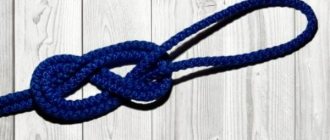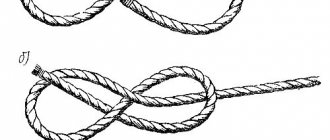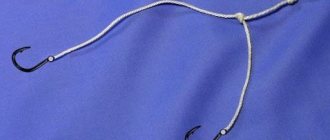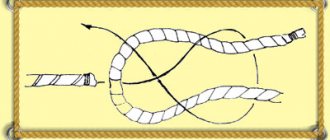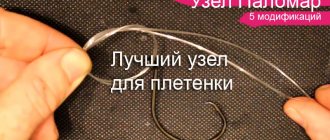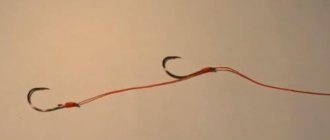Counter conductor
Counter conductor
One of the oldest knots. It can be used for tying ropes of both the same and different diameters; it holds well, is easy to knit and does not “creep”. Also, this is practically the only knot that is suitable for tying ribbons.
Disadvantages: significant weakening of the rope, as well as very strong tightening to the point of impossibility to untie.
I recommend using it for tying ribbons and ribbon-rope combinations, as well as for permanent quickdraws.
Straight
Straight
The “Ashley Book of Knots” (New York, 1977) says the following about the straight knot: “Previously, this knot had a specific purpose in the navy - it was used to tie the reef seasons of the sails when reefs were taken. Previously, sailors had never used it to tie together two ropes if the latter were of different thickness or make. It cannot be used to connect two cables that will be subject to strong traction. This knot crawls and is dangerous when it gets wet. After tying the knot, each of its running ends must be secured with a line to the root end.”
This knot is used to connect two ropes of the same diameter. It is easy to knit and can be relatively easily untied; to do this, you need to strongly and sharply pull the running or root end of one of the ropes. Use without control nodes is not permitted.
Disadvantages: it tightens too much, unties spontaneously (especially on slippery, wet and icy ropes), requires control knots.
I recommend using a direct knot to make unimportant connections of ropes of the same diameter, while not forgetting about the “controls”.
Stirrup (bleached)
Stirrup
This knot has long been used in maritime affairs for attaching castings to the shrouds - transverse sections of resin cable that served as steps for climbing the mast, hence its name. And in the loose version it looks like a stirrup.
It is used as a support for the legs, including in the middle of the rope. They are very convenient for attaching rope to smooth surfaces, such as a mast, log, branch, etc. The stirrup will never be tightened tightly and you don’t even need to untie it; just remove the rope and the knot will fall apart on its own. If one end of the rope is used as the main (loaded) end, then a “control” tied with the running (free) end is needed.
Disadvantages: can “crawl” under variable loads.
The stirrup can be tied in two ways - using loops and one end. When creating a support for the leg, as well as fastening it on an open log, it is convenient to knit a knot using loops. To do this, you need to take the rope with both hands and at the same time twist it so that two loops are formed as in the photo below and then put one on top of the other.
Tying the stirrup with loops
When the support does not have a free end, the stirrup must be tied in the second way - at one end.
Tying the stirrup at one end
The node on the support will look like this:
Stirrup in a tightened form
You can make one more turn around the support with one of the ends of the rope, then the knot will be held tighter.
Counter figure eight knot
In addition to the figure eight with a running end and the figure eight with a turn, I’ll also tell you how to knit a figure eight knot with a counter rope.
The Figure 8 Follow-through knot itself is something between a Figure 8 on a Bight and a Figure 8 Knot, and allows you to get the same knot, but not using a turn, but using the running end.
The need for this arises mainly when you want to tie a figure eight knot around permanent objects (rings, eyes, etc.). Also, the counter figure-eight knot is useful when you are fastening to wide or very high supports on which it is impossible to throw a figure-eight loop in a turn (trees, poles, load-bearing beams, etc.). Well, don’t forget about tying the end of the rope into the loops of individual belay systems (ISS) when climbing rocky routes, for which the figure-eight counter knot is used everywhere.
Counter figure eight (Flemish knot)
Counter eight
The knot originated in Europe about 800 years ago, was used in navigation to fasten the two ends of a cable or rope, and on land it was used to lengthen clotheslines.
The counter-eight knot is a very strong and reliable knot, it does not “creep” and does not greatly reduce the strength of the rope. Used for tying ropes of the same and different diameters, well suited for tying fishing line. Good to use for creating bulges on rope.
Disadvantages: knits slowly and tightens tightly (although not “tightly”).
Types of knot
You will see that the figure eight knot can be used both for tying loops and for tying hooks, baits, various elements with holes, as well as for tying 2 pieces of fishing line or cord. But this knot copes best with loose loops. All purposes are rather far-fetched and it is much more correct to use other, simpler and more reliable knots for hooking and connecting fishing lines.
Creating a loop
Classic (single eight or conductor eight). It is used both in fishing and in mountaineering. A strong knot that creates a non-tightening, stationary loop. Those. you can try to make a loop and then pull both ends of the line coming out of it - you will not be able to tighten the knot. Although there are no connections with 100% strength, and by experimenting, you will find a type of fishing line or cord that can still be tightened if you really want to. For these types of fishing lines (cords) there is a double figure eight. More about her later.
Knitting pattern for a Figure Eight knot to create a loop
Nine (double eight). Almost identical to single, but complicated by one additional step when tying. Stronger on stiffer types of line such as fluorocarbon.
Double figure eight with two loops. A more complicated version is made to create two loops at once with one knot.
Step 1. First make a loop from the double cord, then a second. And pass the middle part of the first loop into the second.
Step 2. Place the loop (number 1 in the image) over the loop number 2.
Step 3. Tighten the knot, pull immediately on 2 loops and two pieces of cord coming out of the knot at the bottom.
Step 4. Double eight is ready. If you use fishing line, be sure to wet it before tightening.
Tying a hook
Fishing. Here the node was simply lucky to be called an eight. There is no need to use such a knot on hooks; there are knots that are more reliable and easier to tie. Nevertheless, it would be wrong not to mention this variety.
Tying two fishing lines (cords)
Counter figure eight - a knot for tying two fishing lines together. As you can see in the diagram, it is indeed possible to tie 2 cords or 2 pieces of fishing line together using a classic figure-eight knot, but the feasibility is very low. The knot is more difficult to knit than the Bloody one and is less durable in this particular connection. And if you need to tie 2 pieces of fishing line of different diameters, then the Carrot knot is even better.
Step-by-step pattern for knitting a counter figure eight knot
Temporarily strengthening a damaged cord
The multiple figure eight is a sea knot that is knitted completely differently than the classic fishing and mountaineering eights. Designed to strengthen a weakened or damaged cord into a knot to prevent it from breaking. It can also be used for deliberately thickening cords or ropes, for example, for tying a handle for a sled.
Simple bayonet
Bayonet
A fairly common maritime knot, it originated in Europe about a hundred years ago. The knot is so reliable that even ships of the royal fleet were tied to the piers with it.
A simple bayonet, despite its simplicity, can withstand enormous loads, never tightens and can be easily untied. Used for tying ropes to supports, eyes, rings, etc. It is necessary to tie a control knot at the free end.
Disadvantages: bayonet nodes “creep”; a control node is required.
I recommend using it to attach it to a support where the rope experiences significant loads (for example, when making a crossing).
Figure Eight Knot – 6 knitting patterns and step-by-step instructions
The Figure Eight Knot is a simple knot for creating a loose loop. Used in fishing and mountaineering. It has several names: guide eight, single eight, double eight and counter.
In the article we will figure out how to knit a figure eight correctly so that the loop does not tighten and we will analyze all the varieties of this connection, their pros and cons. Using 6 knitting patterns, you will understand how to tie a figure-eight loop firmly attached to the fishing line, tie a hook or connect a leash to a thicker fishing line. We also gave examples of analogue units that have their own disadvantages, but also advantages.
Bowline
Bowline
This knot is admired by people who have dealt with cable knitting. And English marine science calls it the “royal” knot. Research shows that the bowline became widespread in the navy of Ancient Egypt and Phenicia several thousand years ago.
The bowline is considered one of the most ancient and perfect sea knots. It has unique properties: it never tightens tightly and does not unravel spontaneously, does not spoil the rope under weight and is very easy to tie. Applicable to all types of ropes and ropes.
A bowline is used to attach a rope to a support, eyes, rings, and so on. Can be used to knit a loose loop. A control node is required.
Disadvantages: can “crawl” under variable loads, requires a control unit.
Prusik
Prusik
Invented by Karl Prusik in 1931, it refers to grasping knots and is used to belay climbers during vertical ascents. When a knot falls, it is tightened on the main rope, preventing it from falling. The Prusik works in both directions and when lifting, you need to keep your hand strictly under the knot. Does not work well on wet or icy rope. In addition to insurance, it can be used for direct lifting (instead of a jumar) and for tensioning a rope using the pulley system. It is tied with a cord with a diameter of 6-7 mm. around 9-14 mm. ropes. It is advisable to knit 3-4 turns.
Disadvantages: it does not always work in case of a fall, especially on an icy rope and with a rigid rope.
Clew and front clew
Sheet (left) and front clew (right)
This unit is a highly specialized marine unit. It was invented and used to fix the sheet in the wing of the sail. This is where it got its name. The clew knot became widespread in the 15th century, when new sailing systems appeared.
The clew knot is very convenient for tying a rope to a finished loop; under heavy load it does not damage the rope. It knits very easily and quickly, and does not tighten under load. Its important feature is that the unit operates only under constant load. When variable, it “creeps”, but without load it unties spontaneously. It is used for tying ropes of the same and different diameters, tying the rope to a finished loop or ring. It is imperative to have control units at the running ends of both ropes.
The clew knot is a further development of the clew knot; it is the last one in the image. To tie it, you need to make another turn of the attached rope around the loop. This knot is more reliable than the clew knot and retains all its positive and negative qualities.
Disadvantages: these units only work under constant load; under variable load they “creep”; they require control units.
Marine knots... what exactly do a diver need them for?
There seems to be a fairly wide selection of carabiners that allow you to attach anything to anything. But then the need arises to urgently attach something underwater, a suitable carabiner is not at hand - and the fun begins! It suddenly turns out that despite the fact that some divers theoretically know how to tie a bowline or figure of eight, practically no one uses them underwater. At best, a straight knot is tied, and at worst, the structures created by divers are beyond description! But there is nothing simpler, cheaper and more reliable than a correctly tied sea knot. This article provides basic patterns for tying sea knots that may be useful to a diver. Of course, this is also just a theory - tying sea knots requires regular practice - then, if necessary, you will be able to use them automatically.
Academic
Academic
This knot is derived from a straight knot, but it has one more turn of the rope around the main rope. It is used for tying ropes of different diameters, it holds well and is relatively easy to untie. You can use a larger number of turns (up to 4). Under variable loads it “creeps”, but, unlike a clew, it does not spontaneously unravel when the load is removed. Requires control nodes. This unit is prohibited from being used for organizing suspended crossings.
Disadvantages: “creeps” under variable loads, requires control units.
The following parts (Knots part 2. More advanced knots, Knots part 3. Rare but useful knots.) will be devoted to useful, but more complex knots, which are also useful to know. But first you need to study these basic components well and be able to apply them in practice.
Technique for knitting a figure eight knot step by step
The figure eight knot is unique in its ease of knitting and practicality. At the same time, it is quite reliable, since it does not unravel spontaneously when tensioned, even when fixed around the support. It is used in both tension and slack ropes, ropes and cables (Figure 8).
Step-by-step instructions will help you on how to tie such a knot:
- We take a rope (fishing line, rope, cord) with one running end.
- We make a loop through which we pass the running end.
- Tighten the knot and fix it at both ends.
Figure 7. Step-by-step tying technique
By repeating the steps described above, you can make several such knots on one rope.
